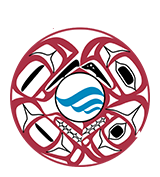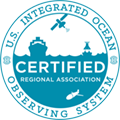The Northwest Association of Networked Ocean Observing Systems (NANOOS) is the Regional Association of the national Integrated Ocean Observing System (IOOS) in the Pacific Northwest, primarily Washington and Oregon. NANOOS has strong ties with the observing programs in Alaska and British Columbia through our common purpose and the occasional overlap of data and products.
Why do we need an ocean observing system?
With threats such as coastal flooding, harmful algal blooms, and low oxygen levels, we need to understand how to best warn and prepare people, arming them with forecasts and data to inform their decisions. The impact on society spans safety, health, local economies, transportation, and commerce.
Before NANOOS, various observing systems already existed, including ocean buoys, satellites, and tide gauges, which collect data to monitor such changes. NANOOS stepped in to demonstrate that these systems and data could communicate with each other, highlighting where additional assets and technology were needed to better understand coastal conditions. The Pacific Northwest needed an observing system that provides an integrated picture of what's happening in our oceans, coasts, and estuaries, and that is what NANOOS was designed to do and continues to evolve to sustain.
What comprises NANOOS?
NANOOS is a partnership of over 40 entities, including industry, state agencies, local governments, tribes, non government organizations, and educational institutions. NANOOS users of data and products who need to make a wide range of decisions about our oceans and estuaries include:
- Mariners
- Fishers
- Search and rescue personnel
- Oil spill responders
- Port authorities
- State resource managers
- Tribal authorities
- Fish and wildlife resource managers
- Coastal managers
- Federal Emergency Management Agency
- Local government planners
- Researchers
- Teachers
- Students
- General public
To serve this varied roster of users NANOOS has prioritized several areas of emphasis for stakeholders:
- Maritime Operations
- Ecosystem Impacts
- Regional Fisheries
- Coastal Hazards (plus tsunamis)
Within these areas NANOOS provides observational and model data plus forecasts, decision-making tools, and new applications to make the business of managing our coastal oceans and estuaries easier than it has been in the past.
What will the future NANOOS do for you?
NANOOS is gearing up to serve your expanding needs. In the future as an external provider you'll be able to add new data that can be accessed and viewed using NANOOS tools. NANOOS plans to provide the following services:
- Discovery Service for Data Service Registration and Lookup
- Metadata Repository for Cataloging Data Types and Formats
- Data Provider Services for sensor observation data or modeling data
- Data Aggregator Services that integrate sensor observations or modeling data
- Portal Data Application Services for viewing Data on graphs or maps
- Portal User Application Services as Decision Support
Dawn of a new Ocean Observing System
NANOOS began in the fall of 2003. A Memorandum of Agreement (MOA) was drawn up at the first workshop to establish the purpose and future direction of NANOOS and to guide all activities and relationships among members. Since its inception in 2003, workshops have been held on governance, system design, industry involvement, and region-specific interests such as dissolved oxygen in Hood Canal and the problem of Oregon coastal erosion.
In 2005, 10 signatory parties activated the agreement. At that time, Dr. Jan Newton became its Executive Director. All signatories established the Governing Council with each signatory entitled to assign a member to serve on the Council.
First Election
In 2006, the NANOOS Governing Council held its first election for four officers and four standing committee chairs. You can check out the names and contact information under People. NANOOS is eager to hear from all those who have an interest in the ocean environment ... which is just about everyone!
Take a look, too, at the original Documents that date back to when NANOOS was a prototype project and forming alliances with all of its constituencies.
NANOOS Today
Currently, NANOOS has grown to include over 50 signatories, Members representing the interests of all the different regions and sectors: industry, government (federal tribal, state, local), non-governmental organizations, education, and research. NANOOS and all of its users are benefiting from these members' commitment to furthering the scientific and operational design and maintenance of the Pacific Northwest regional ocean observing system.
| National Observing System Partners Alliance for Coastal Technologies (ACT) Southeastern Universities Research Association (SURA) Integrated Ocean Observing System IOOS | |||||||

